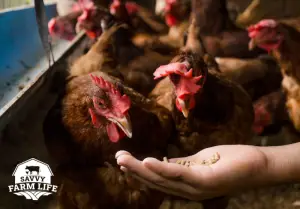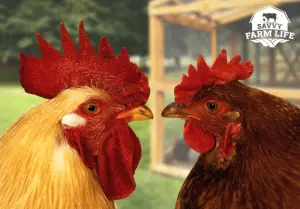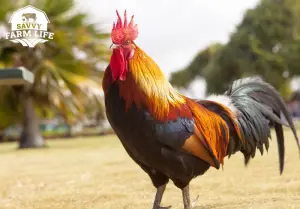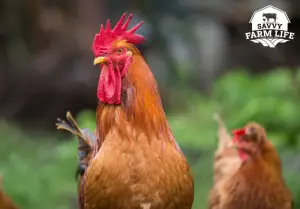Eating Roosters: What You Should Know
You may never have thought about the gender of the bird that you purchased at the grocery store, but there is a benefit to knowing more about the chicken that you eat. When you know about the animal behind the packaging, you develop a healthy respect for what you eat and how they have lived. Does gender matter when it comes to meat chickens? Are roosters typically used in today’s meat bird market, and if so, can they be raised for meat on a homestead just as easily?
Can you eat roosters? You can eat roosters, and you likely do on a regular basis. Mass producers do not sex chicks; they raise and process the female chickens just as they do the males. Likewise, if you purchase chicks specifically for meat, there would be no reason to separate the cockerels (immature roosters) from the pullets (immature hens).
Whether you get your meat from the grocery store or your backyard, it is good to know more about your meat and the birds behind it. Read on for more information on roosters, including the age at which you can process them and the breeds that perform best.
Eating Roosters: The Facts Behind Grocery Store Chickens 
The United States is the largest producer of meat chickens in the world, with an estimated 9 billion chickens processed every year. For comparison’s sake, the US processes approximately 32 million heads of cattle and 121 million hogs annually. This means that the US processes as many chickens annually as 281 years worth of cattle, or 74 years worth of hogs.
Trailing the US in meat chicken production are China and Brazil. These three countries make up the vast majority of chicken production, processing millions of tons of chicken meat each year. If you are a regular purchaser of poultry, it should not surprise you to learn that Tyson is the #1 producer of chicken meat in the US, with Pilgrim’s Pride the #2 producer.
Can You Eat An Old Rooster?
If you discover that your new batch of pullets includes an unwanted rooster or two, you may decide to use these cockerels for meat. If that is your choice, it is best not to dawdle – process the rooster as soon as it has put enough weight on it to make it worth your while, as the older it gets the tougher its meat will become.
Perhaps you didn’t mind the little guy that was included in your batch of pullets, but that sweet cockerel has turned into a mean old rooster that you are not keen to keep. You can certainly eat an older rooster; you will just need to adjust your cooking method. You won’t be getting barbecued or fried chicken from your old rooster, but you can get a nice soup from him. The key to cooking tough meat is to cook it slow, to cook it on low heat, and to cook it in a moist environment.
Another tip for cooking an older bird is to put the meat in the refrigerator for a few days after processing – this will allow the fibers to relax and will allow a bit more tenderness.
Eating Roosters: Chicken Producers Practice Gender Equality 
If you have done a search on whether poultry companies use roosters in their meat, you may have read that grocery store meat is primarily female, as the companies sex their chickens. This is not true. These mass producers of poultry do not discriminate by gender, and why should they? Despite claims that you may have heard, there is no breed of chicken that produces “only female chicks”. 50% of hatched chicks will be male, and 50% will be female. If you remove the males from the operation, you are decreasing the world’s available chicken meat by half. That would be devastating to the world’s meat market, the economy, and would be sadly wasteful of the chickens themselves.
Of course, the process of sexing chicks would also add a significant amount of time and money to the massive business that is meat birds, and no company wants to add cost to a business model for a practice that would only bring harm to their profit margins. The videos you may have seen of breeders sexing chicks and discarding the males is a sad truth of the chicken breeder business, but has nothing to do with meat birds. The reason the males are removed in these situations is because they cannot lay eggs. Eggs are also big business, and roosters do not lay eggs. For this reason, in the layer industry, male chicks are often discarded.
Popular Rooster Breeds For Meat
You may have heard that mass producers are able to raise big birds in a short period of time because they pump hormones into them. This is another myth – there is no truth to this. Birds bred specifically for meat have been selectively bred over decades, just like the different breeds of any other animal.
Meat birds are bred to grow quickly, have large breasts, and most are white to produce a more appealing carcass. The birds that Tyson uses are of a proprietary “formula” and are called the Cobb 500. It is believed that these birds are a cross between the White Cornish and the White Plymouth Rock. Tyson actually owns their own breeder company, so you are unlikely to be able to find Cobb 500 chicks to raise on your own.
If you would like to raise chickens for meat on your own homestead, there are a number of online hatcheries that sell meat birds, and you may get lucky at your local feed store as well. . Meat breeds are very different from layer breeds in both size and maturity rate. The most popular breed of chicken to raise for meat is the Cornish Cross (aka Cornish X).
This bird has been used for decades in the meat industry, and in fact the Cobb 500 described above is a type of Cornish X. These birds grow rapidly, have thick legs to hold up their giant frames, have large breasts, and white feathers. They are not nearly as active as heritage breeds, instead preferring to sit or lie by the feeder instead of walking around and pecking the ground. Because of both the physical and behavioral attributes of the Cornish X, most of the other chicken breeds commonly described as “meat breeds”will not be able to compete with the Cornish X in terms of efficient meat production.
Do you have the time to grow out a heritage breed, and the inclination to do so? Other popular meat breeds include the Barred Rock, Black Giant, Deleware Broiler, and White Giant. If you would like to get both eggs and meat from your birds, you can’t go wrong with a dual-purpose breed like a Buff Orpington, Brahma, or a Wyandotte. All of these birds are of a large size, but most will take longer to grow out.
At What Age Is A Rooster Ready To Process? 
If you have ever eaten an older chicken, you will know that you need a young bird if you want to eat anything other than a slow-cooked bird. The older the chicken, the tougher the meat, and by “tough” we mean you will be getting a jaw workout chewing that bird unless it is very slowly cooked.
Ideally, you will want to process your meat birds as early as possible while letting them grow enough to have put on an ample amount of meat. The lovely thing about the commercial breeds is that they grow at a rapid rate compared to other birds – this means less time spent caring for them and less feed (theoretically) purchased for them.
The Cornish X can easily reach a processing weight in as little as 8-9 weeks. Because of the size of these birds, it is recommended you process them before 12 weeks at the latest. They will become so heavy that some have been known to be unable to support themselves by the time they reach this age. While there are stories of Cornish X being kept by homesteaders to breed, they are not a prolific (or hardy) breed and a heritage breed should be selected if one would like a self-sustaining meat supply.
Go Ahead And Eat That Rooster
You may have been curious about roosters because you are hoping to learn more about the meat that you purchase from the grocery store. Or, you may have been wondering about roosters because you are embarking on your own meat-producing journey and have never raised a rooster before.
It is also likely that you may be thinking about eating roosters because you have found yourself in the predicament many of us have found ourselves in, and are needing to find a humane and useful way of removing an unwanted rooster from your flock. Whatever your situation, rest assured that you can eat a rooster the same way as you would eat a hen – easily if processed early, and slow-cooked if processed later.

